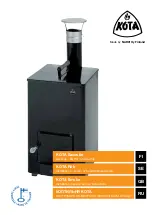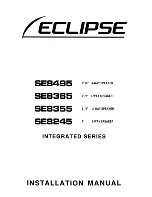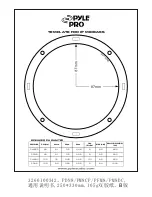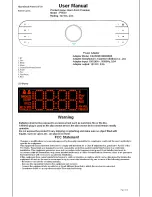
The GENELEC HT330A active loudspeaker
is designed for neutral sound reproduction at
high SPLs in large Home Theater rooms. The
system comprises of a 320 litre loudspeaker
cabinet and a 19” 7U rack mount amplifier
unit.
The cabinet contains two 385 mm (15”)
bass drivers, a 130 mm (5”) midrange, and
a 25 mm (1”) treble driver. The midrange
and treble drivers are mounted in a Genelec
Directivity Control Waveguide™ (DCW™)
which can be rotated through ±90° for either
horizontal or vertical mounting. The cabinet
low frequency -3 dB point is at 29 Hz and the
bass response extends down to 25 Hz. The
high frequency response extends up to 22 kHz
(-3 dB).
Each amplifier unit contains a three-chan-
nel active crossover, driver overload protec-
tion circuits, and four separate power ampli-
fiers producing 2 x 400 W, 350 W and 120 W
of short term power in the bass, midrange,
and treble channels respectively. The crosso-
ver filter incorporates tone controls to enable
the user to accurately match the speaker to
the local acoustic environment.
Unpacking
The Genelec HT330A can be transported as
a pair or as a single system. A pair is shipped
in a single box, containing two cabinets, two
amplifier units, two mains connecting cables,
two LED connecting cables, two loudspeaker
connecting cables and one Allen key. (See
Fig 1)
Before installing the system, check all
items for damage and omissions. If there are
any damaged products, contact directly the
distributor and insurance agent. If there are
any missing components, contact your local
dealer or Genelec.
Installing the amplifier
The Genelec HT330A amplifier electronics
are encased in two standard 19” 7U rack
cases. The unit should be well ventilated to
prevent excessive overheating, there must
be a supply of air to the front and sufficient
ventilation to dissipate the generated heat
from the space behind the amplifier unit. The
maximum permissible ambient temperature
is 35° C (95° F) If the system overheats it
will stop operating until a safe temperature
is reached.
Make sure that the amplifier is positioned
so that the loudspeaker connecting cables
will reach. Longer cable lengths can be
ordered from the manufacturer upon special
request. A space 120 mm deep should be left
behind the rear panel of the amplifier unit to
allow for the cable connectors.
Check that the amplifier unit is wired to the
correct mains voltage for your power supply.
The correct mains voltage for the amplifier
unit is shown at the bottom of the sticker on
the rear panel of the amplifier unit.
Loudspeaker positioning
The HT330A control room monitor is designed
to be flush mounted in either the vertical or
horizontal configuration. The DCW™ should
be rotated so that the treble and midrange
drivers align vertically. This ensures that opti-
mum stereo symmetry is obtained.
Note that the DCW™ plate is heavy, care
must therefore be taken when removing and
replacing the DCW™. To rotate the DCW™
plate, proceed as follows:
• Place the loudspeaker in its intended
listening orientation.
• Unscrew the eight M5 fixing screws on
the edges of the plate using the 4 mm
Allen key provided with the system.
• Carefully pull the plate a small distance
away from the cabinet.
• Rotate the DCW™ so that the midrange
and treble drivers are aligned vertically
(treble driver on top) and remount the
DCW™ plate reversing the procedure
above.
Flush mounting of the
loudspeaker
Although the HT330A may be used success-
fully as a free standing speaker, flush mount-
ing is strongly recommended for acoustical
reasons. Flush mounting improves the bass
response and efficiency and also enhances
the midrange transient and frequency
response.
The loudspeaker has its acoustical axis
midway between the midrange and treble
drivers. This axis should be used as the lis-
tening and measuring axis of the system.
(See Fig 2.1 and Fig 2.2)
The listening position should be between
2 ... 3.5 m (6½ ... 11½’) from the loudspeak-
ers. The loudspeaker should be aimed so
that the acoustical axis of the two loudspeak-
ers meet at ear height at the center of the
listening area. The loudspeakers should not
be mounted too high as this increases the
required vertical tilt of the loudspeaker and
reduces the optimum listening area.
The ceiling, side walls and especially the
rear wall should be acoustically absorbent at
low frequencies. The loudspeaker mounting
wall should be acoustically hard and there-
fore reflective. The mounting wall should be
angled so that the loudspeakers are correctly
aimed. Great care should be taken over how
the loudspeaker is mounted into the wall.
Note the following:
• A space 50…100mm (2..4”) wide can be
left around the loudspeaker.
• Cover the space around the
loudspeaker with a facing panel, this
should be fixed to the wall. Leave a gap
of about 5..10 mm (¼..½”) between the
loudspeaker and the panel. Fill this gap
with a soft rubber gasket to allow for
possible cabinet movement.
• Ensure that the loudspeaker cables can
reach the rear of the loudspeakers.
• If a light (e.g. wooden) wall is used,
the loudspeaker cabinet should be
mounted on vibration isolators, with a
resonant frequency of around 2…8 Hz,
to prevent vibrations from being
transmitted to the wall and impairing
the low frequency performance. The
space around the cabinet should be
filled with absorbent mineral wool or
foam plastic. The walls must be well
braced.
• For a solid wall (e.g. concrete), the
loudspeaker may be directly mounted to
the wall without vibration isolators. The
space around the cabinet should be
filled with mineral wool or sand bags.
Discontinuities in the mounting wall will cause
diffraction, which leads to inferior frequency
response and stereo imagery, so:
• Ensure that the cabinet is flush with the
surface of the wall.
• If a decorative cloth frame is used to
cover the wall, make sure that the edges
adjacent to the speaker are less than
20 mm (3/4”) deep. The cloth must be
very thin Tricot or acoustically
transparent material, otherwise the high
frequency response of the system will
be adversely affected. Genelec
approved cloth grilles are available (part
number 1039-409).
System
























